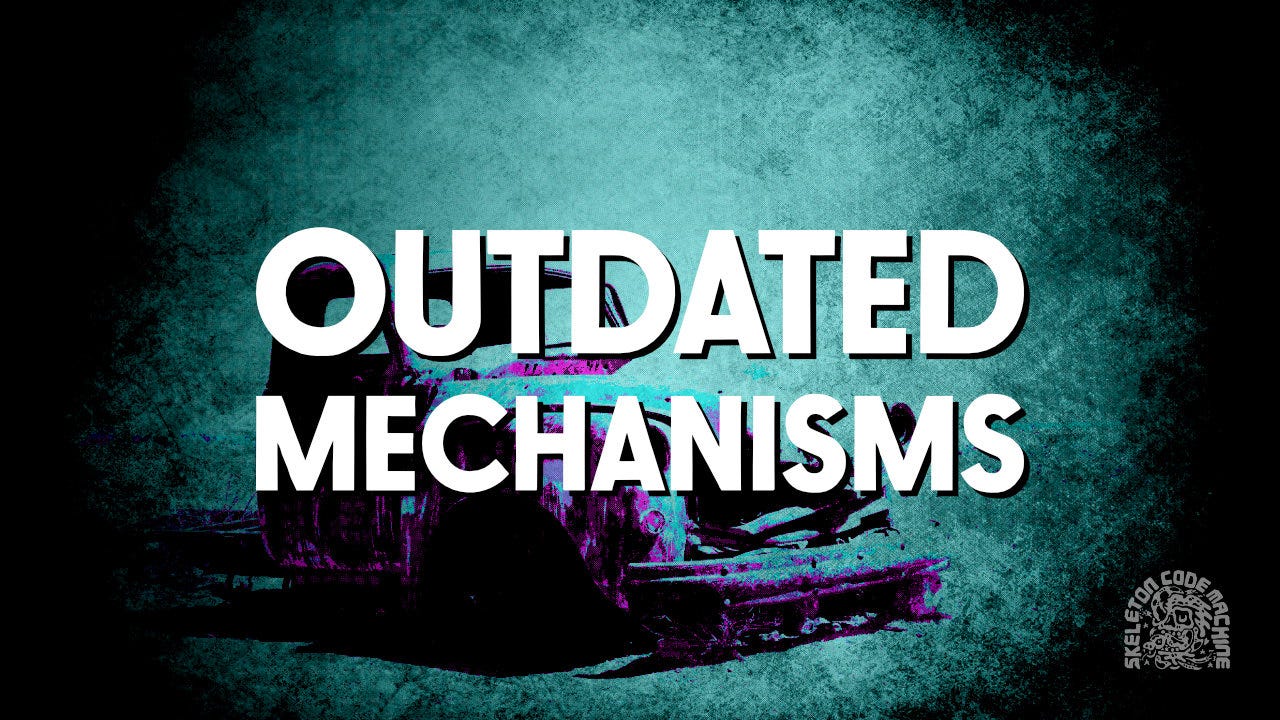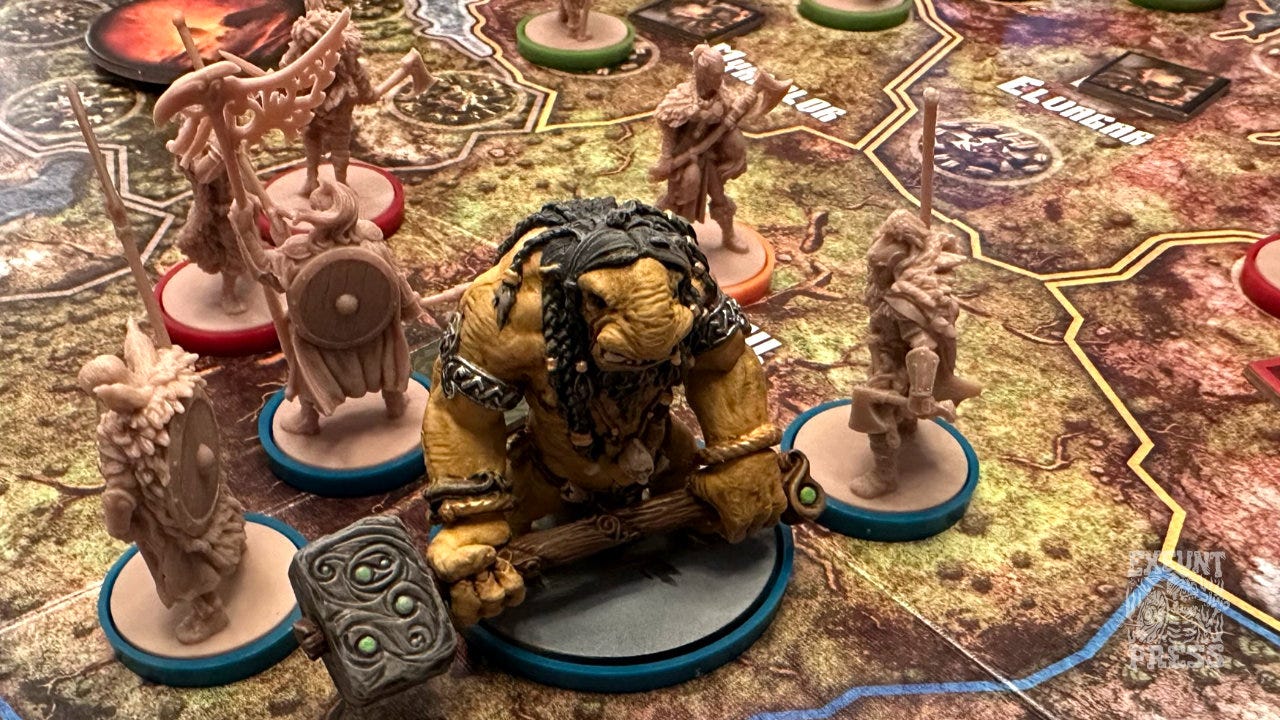Outdated game mechanisms
5 game mechanisms that have fallen out of favor
Welcome to Skeleton Code Machine, a weekly publication that explores tabletop game mechanisms. Spark your creativity as a game designer or enthusiast, and think differently about how games work. Check out Dungeon Dice and 8 Kinds of Fun to get started!
Last week we looked at SCOUT and how it uses ladder climbing mechanisms. In the post I wondered how this might be applied in TTRPGs. Thanks to Lorenzo Trenti for pointing out that Motobushido RPG uses something much like ladder climbing during duels!
This week we are looking at outdated tabletop mechanisms. Inspired by the Board Game Barrage podcast Episode 287, we explore if these mechanisms have had their time and place.
Falling out of favor
There was a time when one might describe a board game by saying it had dice rolling or uses cards. The language and vocabulary of game mechanisms has expanded over the years. BGG now lists over 190 different specific game mechanisms from Action Drafting to Zone of Control.
A classic game like Monopoly (Darrow & Magie, 1935) might now be described as: Auction, Income, Loans, Lose a Turn, Ownership, Player Elimination, Roll and Move, Set Collection, Stock Holding, and Trading.
A few of these mechanisms have fallen out of favor over time. Some players might recoil at the thought of playing a game with player elimination or roll and move.
Let’s look at five specific mechanisms that might be considered outdated in modern game designs:
1. Memory games
Hidden, trackable information whose tracking gives players an advantage.
Most of us would be familiar with the classic game of Memory (1959) where you take turns flipping face down cards until you find pairs. The game relies on remembering card positions after seeing them.
I’m not exactly sure why games that rely heavily on memory have fallen out of favor. It could be an accessibility issue, as it becomes a test of the player’s memory recall rather than of strategy. It could be a reduction in player agency and choice, because either you remember the information or you don’t.
If you have some theories on this one, I’d love to hear them in the comments!
2. Roll and move
Roll dice or use a spinner to determine how far to move along a track.
Roll and move is the classic mechanisms of many children’s games like Candy Land (Abbott, 1949). It’s a great way to teach children how to take turns, play tabletop games, and give them a chance at winning.
Unfortunately, this mechanism also removes player agency and choice. In the worst forms, it can reduce a game to zero choice: roll dice, move the specified amount. In better cases, the roll might be mitigated or modified in some way.
My guess is that this one has fallen out of favor because it can limit player agency and choice if not carefully implemented.
3. Player elimination
A player can be removed from the game, no longer participating.
When people sit down to play a game, there is tacit agreement that everyone will get to play. In a game with player elimination, a player might be knocked out of the game early and forced to sit out. That’s simply not fun.
I was recently talking to someone about a new 2-4 player skirmish board game, and I asked how player elimination is handled. What happens if someone is knocked out early? They said that player would just sit out until the next game. When I asked how long a typical four player game might be, they said 1-2 hours.
While player elimination might be OK in short games, I’m not sure anyone would enjoy sitting out of a game for 30+ minutes.
4. Take that
Taking an action that targets another player, hurting their chance of victory.
Here’s how BGG describes take that mechanisms:
Competitive maneuvers that directly target one opponent's progress toward victory, but do not directly eliminate any characters or components representing the opponent. Such mechanics include stealing, nullifying, or force-discarding of one opponent's resources, actions, or abilities. A take-that maneuver often results in a dramatic change in the players' position of power over a relatively short period of time.
Basically, Munchkin (Jackson, 2001).
Much like player elimination, I think this depends on game length, number of players, and other factors. In a short, two player game, take that can be lots of fun. At higher player counts, players can feel targeted and unhappy. Similarly, some players can feel anxiety when forced to choose who to target with a take that action.
Of the five mechanisms, this one is perhaps the one that still gets a lot of use. It is, perhaps, more a question of how it is implemented.
5. Dice combat
Players roll dice to resolve a combat encounter.
While dice combat doesn’t have a BGG mechanic entry, I think it’s worth listing. Risk (Lamorisse & Levin, 1959) is a classic example, where attacker and defender roll dice and compare values.
Much like roll and move, I think this one comes down to player agency and choice. It’s just not a lot of fun to lose battles because of poor dice rolls. While some luck can add some excitement, having more control can create a more satisfying player experience. Modern games might add ways to mitigate or modify the dice rolls, or reduce the consequences of poor rolls.
Some games ditch dice altogether and opt for zero-luck combat!
Proceed with caution
Does this mean these mechanisms should never be used? Absolutely not!
It does mean, however, that some caution should be used when implementing them to ensure they add to the player experience. Like any tool, they can be wonderful when used correctly and for the right purpose. They might detract from a game when implemented poorly.
Notable examples
When a modern game takes one of these ideas and implements in a novel and interesting way, some real magic can happen.
Let’s look at some examples of these mechanisms implemented in ways that work well:
Cthulhu: Death May Die (player elimination): Your character can die, and you’ll be eliminated from the game. This is mitigated by two things: (1) it’s usually late game when you die, and (2) as soon as one player dies, the whole team is quick to follow and die as well. Players never sit out for long, even if the overall game is long.
Ankh: Gods of Egypt (player elimination): Get out of the red zone on the Devotion track by the end of the 4th Conflict or be forgotten and eliminated. In three player games, however, the bottom two gods merge and play as a team for the remainder of the game. (Check out the DT review of Ankh.)
Blood Rage (memory): While you could just draft the best card in the hand given to you, remembering which cards are moving around the table gives you a strong advantage.
Undaunted: Normandy (dice combat): Roll attack dice and if they are equal to or greater than the defender’s total defence value, the attack is successful. By itself, this can lead to unsatisfyingly bad dice rolls. Your overall success in the game, however, relies more on deck building and movement than on any single dice roll.
I think tolerance for these mechanisms is impacted by what the player wants to get out of a game. This is where learning player types via the Bartle Taxonomy, Eight Kinds of Fun, and Quantic Motivation Model can help with game design.
Conclusion
Some things to think about:
Game design trends change: Roll and move games used to be popular. Legacy games were very hot recently. Today trick-taking and roll and write games are extremely popular. It’s worth keeping an eye on the future of tabletop games.
Use caution: While these mechanisms might seem outdated, that doesn’t mean they shouldn’t be used. It does mean, however, that there is a risk of implementing them poorly and in a way that reduces player satisfaction.
Old mechanism with a twist: Coming up with a new and interesting way to incorporate these elements into your game can be really rewarding. Player elimination and “the merge” in Ankh: Gods of Egypt is a great example of innovation.
In this week’s poll, I’m curious what you think! Can tabletop game mechanisms become outdated? If so, should they be avoided or used with caution?
— E.P. 💀
P.S. You should check out Eleventh Beast.
Skeleton Code Machine is a production of Exeunt Press. If you want to see what else is happening at Exeunt Press, check out the Exeunt Omnes newsletter.





For a fantastic example of Roll & Move done well, I suggest you check out Spy Alley (https://boardgamegeek.com/boardgame/1986/spy-alley). It does three things that make the mechanic sing:
1. Most of the spaces that players land on offer them choices, usually choices of what to buy. Where they land might not be up to them, but what they do once they land there certainly is.
2. Players eventually acquire Move cards that they can play in leiu of rolling the die, letting them override the randomness when it really matters to them. Deciding when to use up your Move card and when to save it for later is a big part of the strategy.
3. The object of the game is to acquire a set of four items unique to your character, and then make it to an Embassy space unique to your character -- without letting anyone figure out which character you are. Because the game is mostly about this hidden identity mechanic, a lot of the player interaction takes place above the board instead of on it. It also makes the randomness feel mostly like a positive. Oops, I randomly landed on the password space I wanted -- I guess I might as well buy it! Whereas choosing to move there would be really suspicious.
Memory games and roll & move are still popular for small children, at least here in France. But lemme tell ya, my former university colleagues (ESL teachers) weren't too pleased when I suggested that their roll & move "Let's Speak English" game was infantilizing, haha... But hey, it sometimes worked for short bursts to get some students to speak a bit, so maybe I was being an ass.